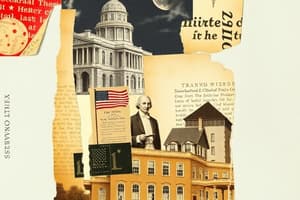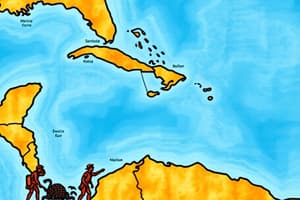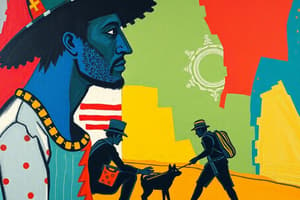Podcast
Questions and Answers
Which statement accurately describes the reason for the establishment of the New England colonies?
Which statement accurately describes the reason for the establishment of the New England colonies?
- They were founded primarily for economic gain.
- They were settled by French and Irish immigrants.
- They were started by English Pilgrims seeking religious freedom. (correct)
- They were intended as a penal colony for English convicts.
What were the primary economic activities in the New England colonies?
What were the primary economic activities in the New England colonies?
- Mining for precious metals.
- Manufacturing of textiles and clothing.
- Fishing, whaling, and shipbuilding. (correct)
- Agriculture, including tobacco and rice.
Which of the following best describes the demographic composition of the Middle colonies?
Which of the following best describes the demographic composition of the Middle colonies?
- Exclusively populated by Dutch settlers.
- A mix of different nationalities including French, Irish, German, and Italian. (correct)
- Mostly comprised of Spanish settlers seeking gold.
- Predominantly settled by English immigrants only.
What were the primary cash crops grown in the Southern colonies?
What were the primary cash crops grown in the Southern colonies?
What was the role of indentured servants in the early American colonies?
What was the role of indentured servants in the early American colonies?
How did the status of African slaves differ from that of indentured servants?
How did the status of African slaves differ from that of indentured servants?
What was one consequence of the dependence on cash crops in the Southern colonies?
What was one consequence of the dependence on cash crops in the Southern colonies?
What significant event later arose as a consequence of the institution of slavery in America?
What significant event later arose as a consequence of the institution of slavery in America?
What significant development did the Sumerians contribute to early civilizations?
What significant development did the Sumerians contribute to early civilizations?
Which civilization is known for its advancements in astronomy and mathematics using a base 60 system?
Which civilization is known for its advancements in astronomy and mathematics using a base 60 system?
What role did Confucius play in ancient Chinese civilization?
What role did Confucius play in ancient Chinese civilization?
Which of the following is a notable aspect of Roman civilization?
Which of the following is a notable aspect of Roman civilization?
Which civilization is considered the birthplace of democracy?
Which civilization is considered the birthplace of democracy?
During which period did the Great Migration and the establishment of feudalism occur?
During which period did the Great Migration and the establishment of feudalism occur?
What characterized the social system of feudalism during the medieval period?
What characterized the social system of feudalism during the medieval period?
What major event exposed European societies to new ideas and influenced social structures during the Middle Ages?
What major event exposed European societies to new ideas and influenced social structures during the Middle Ages?
What was the significance of the Mayflower Compact signed in 1620?
What was the significance of the Mayflower Compact signed in 1620?
Which battle is considered a turning point in the American Revolution due to its impact on foreign support?
Which battle is considered a turning point in the American Revolution due to its impact on foreign support?
What was the main purpose of the Articles of Confederation?
What was the main purpose of the Articles of Confederation?
Which event directly contributed to the American colonies' desire for independence from Britain?
Which event directly contributed to the American colonies' desire for independence from Britain?
Which document formally ended the American Revolution?
Which document formally ended the American Revolution?
What was the primary effect of the Louisiana Purchase in 1803?
What was the primary effect of the Louisiana Purchase in 1803?
During George Washington's presidency, which of the following was a significant event?
During George Washington's presidency, which of the following was a significant event?
What does the term 'mercantilism' refer to in the context of colonial America?
What does the term 'mercantilism' refer to in the context of colonial America?
What was the primary purpose of the Indian Removal Act of 1830?
What was the primary purpose of the Indian Removal Act of 1830?
Which event marked the beginning of the Civil War?
Which event marked the beginning of the Civil War?
What was a significant outcome of the Emancipation Proclamation?
What was a significant outcome of the Emancipation Proclamation?
Which era is characterized by rapid industrialization and significant social changes in the U.S.?
Which era is characterized by rapid industrialization and significant social changes in the U.S.?
Which factors contributed to the outbreak of World War I?
Which factors contributed to the outbreak of World War I?
Who were the main Allied Powers during World War I?
Who were the main Allied Powers during World War I?
What role did the assassination of Archduke Franz Ferdinand play in World War I?
What role did the assassination of Archduke Franz Ferdinand play in World War I?
Which legislation aimed to reform social issues such as labor rights and women's suffrage?
Which legislation aimed to reform social issues such as labor rights and women's suffrage?
Flashcards
New England Colonies
New England Colonies
Colonies in present-day New Hampshire, Massachusetts, Rhode Island, and Connecticut, founded by English Pilgrims seeking religious freedom. Primarily focused on fishing, whaling, and shipbuilding.
Middle Colonies
Middle Colonies
Colonies in present-day New York, New Jersey, Pennsylvania, and Delaware; settled by diverse nationalities. Known for industrial work and growing crops like wheat.
Southern Colonies
Southern Colonies
Colonies in present-day Virginia, North Carolina, South Carolina, Georgia, and Maryland. Characterized by rich land, good weather, and large plantations growing cash crops like tobacco, rice, and cotton.
Indentured Servants
Indentured Servants
Signup and view all the flashcards
African Slaves
African Slaves
Signup and view all the flashcards
13 Colonies
13 Colonies
Signup and view all the flashcards
Cash Crops
Cash Crops
Signup and view all the flashcards
Colonial Region
Colonial Region
Signup and view all the flashcards
Jamestown Settlement
Jamestown Settlement
Signup and view all the flashcards
Mayflower Compact
Mayflower Compact
Signup and view all the flashcards
Mercantilism
Mercantilism
Signup and view all the flashcards
French and Indian War
French and Indian War
Signup and view all the flashcards
Declaration of Independence
Declaration of Independence
Signup and view all the flashcards
Battles of Lexington and Concord
Battles of Lexington and Concord
Signup and view all the flashcards
Common Sense
Common Sense
Signup and view all the flashcards
Treaty of Paris (1783)
Treaty of Paris (1783)
Signup and view all the flashcards
Assimilation
Assimilation
Signup and view all the flashcards
Latitude
Latitude
Signup and view all the flashcards
Longitude
Longitude
Signup and view all the flashcards
Equator
Equator
Signup and view all the flashcards
Fertile Crescent
Fertile Crescent
Signup and view all the flashcards
Bronze Age
Bronze Age
Signup and view all the flashcards
City-State
City-State
Signup and view all the flashcards
Feudalism
Feudalism
Signup and view all the flashcards
Trail of Tears
Trail of Tears
Signup and view all the flashcards
Indian Removal Act
Indian Removal Act
Signup and view all the flashcards
What were the main causes of World War I?
What were the main causes of World War I?
Signup and view all the flashcards
Allied Powers
Allied Powers
Signup and view all the flashcards
Central Powers
Central Powers
Signup and view all the flashcards
Emancipation Proclamation
Emancipation Proclamation
Signup and view all the flashcards
Reconstruction
Reconstruction
Signup and view all the flashcards
Gilded Age
Gilded Age
Signup and view all the flashcards
Study Notes
Colonial America
- Thirteen colonies were established on the east coast of the present-day US, primarily by English settlers.
- The colonies can be grouped into three regions: New England, Middle, and Southern, each with distinct characteristics and lifestyles influenced by geography.
New England Colonies
- Comprised of present-day New Hampshire, Massachusetts, Rhode Island, and Connecticut.
- Founded by English Pilgrims seeking religious freedom.
- The Pilgrims' ship, the Mayflower, was initially on a wrong course and landed in Plymouth, Massachusetts.
- Key economic activities included fishing, whaling, and shipbuilding, due to the cold climate unsuitable for agriculture.
Middle Colonies
- Included present-day New York, New Jersey, Pennsylvania, and Delaware.
- Diverse populations, including French, Irish, German, Italian, and English settlers.
- Main economic activities were industrial work and growing staple crops like wheat.
Southern Colonies
- Included present-day Virginia, North Carolina, South Carolina, Georgia, and Maryland.
- Favourable climate and fertile land allowed for cash crop cultivation, such as tobacco, rice, and cotton.
- Plantations were the primary means of agricultural production, requiring large-scale labor.
Indentured Servants
- Faced high travel costs to the colonies from England.
- Some poor people borrowed money from wealthier individuals in exchange for their labor.
- Indentured servants typically served for four years before gaining freedom.
- Some indentured servants could be sold as slaves to other wealthy individuals.
African Slaves
- Africans were forcibly brought to the US colonies as slaves.
- Denied basic human rights and worked for life under their owners.
- The institution of slavery was a significant contributor to the later US Civil War.
Convicts
- English courts sent convicts to the US colonies to reduce the prison population in England.
- Unskilled convicts worked on plantations; skilled convicts worked as tradesmen.
- Following their sentences, some convicts returned to England, while others integrated into colonial society.
Studying That Suits You
Use AI to generate personalized quizzes and flashcards to suit your learning preferences.




